Airplane Seat-Back Pockets Germier Than Toilet Handles

Concerned about germs while traveling by plane? It turns out that your seat-back pocket might actually be germier than the toilet handle, according to a new study, which also suggests that certain bacteria can linger on surfaces within airplanes for longer than a week.
In the study, researchers found that the antibiotic-resistant bacterium known as MRSA (Methicillin-resistant Staphylococcus aureus) lived on material from a seat-back pocket for a week, which is longer than it lived on any other surface found in airplanes. It actually lasted for the shortest amount of time on the toilet handle.
The bacterium E. coli O157:H7, a common culprit in outbreaks of foodborne illness, survived longest on the material from the armrest, living there for four days.
"We do not know how likely it is for a passenger to get infected, but the odds are higher when groups of people are put into a crowded room or cabin," said James M. Barbaree, an associate director for research at Auburn University in Alabama. [6 Superbugs to Watch Out For]
"Good hygiene practices lower the risk" of getting sick, Barbaree told Live Science.
The bacteria the researchers looked at are common in the environment, and people may be exposed to them and not even get sick. However, E. coli O157:H7 may cause severe diarrhea, and can even lead to hemolytic-uremic syndrome, a disorder that destroys blood cells and can be fatal, especially in children younger than age 5 and older adults. Infection with MRSA can cause skin diseases and pneumonia.
In the study, the researchers tested how long MRSA and E. coli bacteria could survive in an aircraft cabin while exposed to typical airplane conditions that included human sweat and saliva. The researchers tested the bacteria's "survival skills" on six surfaces they obtained from a major airline carrier: an armrest, a plastic tray table, a metal toilet handle, a window shade, a seat pocket cloth and seat leather.
Get the world’s most fascinating discoveries delivered straight to your inbox.
The reason certain types of bacteria survived longer on plane surfaces may be related to their differing structures, the researchers said.
"Bacteria vary in their outer membrane components," which can make them more or less susceptible to adverse environmental conditions, Barbaree said. "The species also vary in their tolerance of certain environmental conditions, such as temperature and humidity."
The researchers said their next step will be to test the survival and transmission of other potentially dangerous bacteria, such as Mycobacterium tuberculosis — which causes tuberculosis — on airplanes.
Even though the new study suggested that harmful bacteria survived longer on other surfaces than they did on toilet handles, previous research has shown that airplane bathrooms are teeming with pathogens.
"It's probably the germiest toilet you'll come across," Charles Gerba, a microbiology professor at the University of Arizona, told Live Science in a 2011 interview.
In one of his studies, Gerba collected bacteria from 20 planes. Airplane bathrooms turned out to be the most bacteria-infected spots on planes. As many as 75 people use the bathrooms between cleanings, he said.
Gerba also found E. coli bacteria in the bathrooms.
The new study by the Auburn University researchers was presented today (May 20) at the 2014 general meeting of the American Society for Microbiology in Boston, and has not been published in a peer-reviewed journal. The research was funded by the U.S. Federal Aviation Administration's (FAA) Office of Aerospace Medicine.
Follow Agata Blaszczak-Boxe on Twitter. Follow Live Science @livescience, Facebook & Google+. Original article on Live Science.


